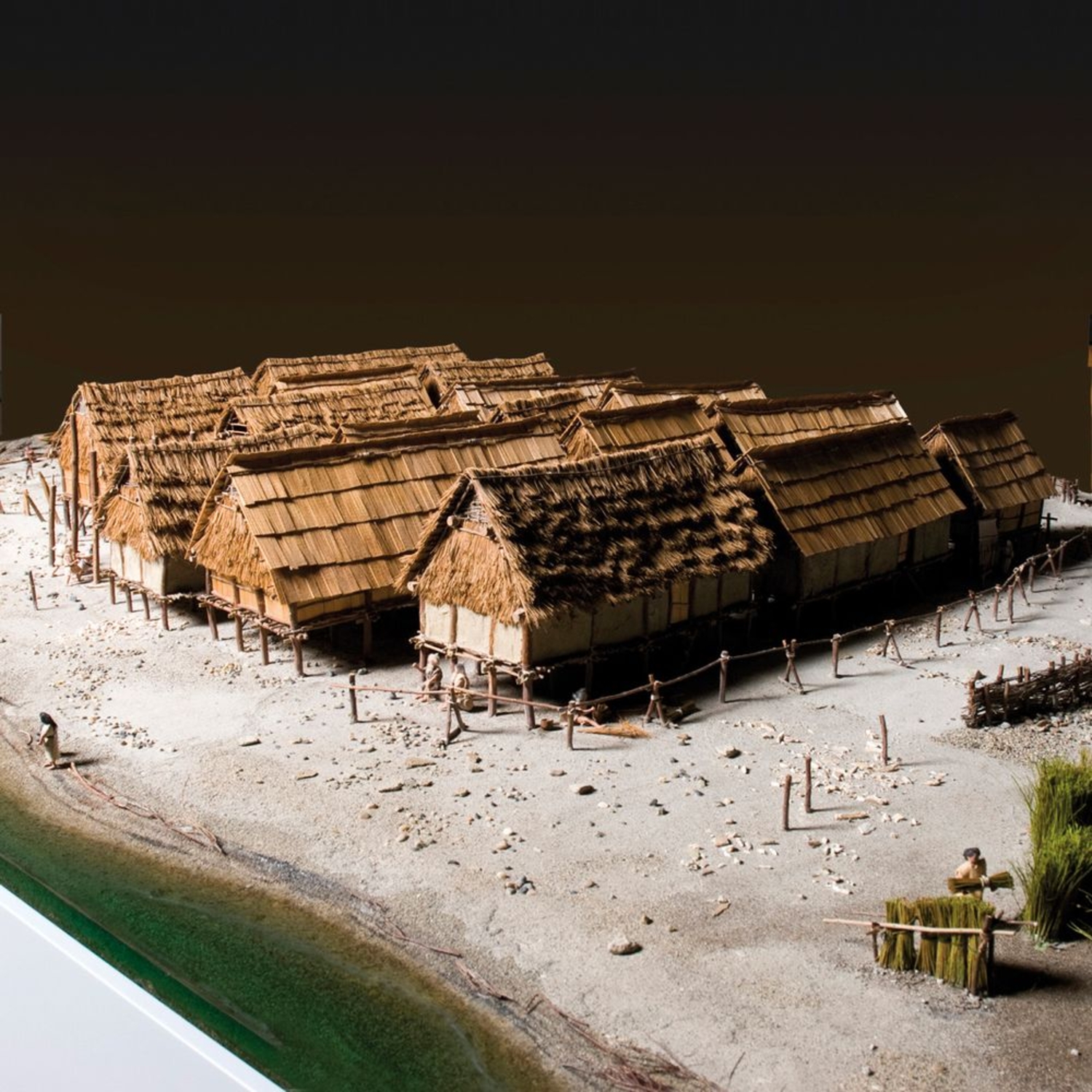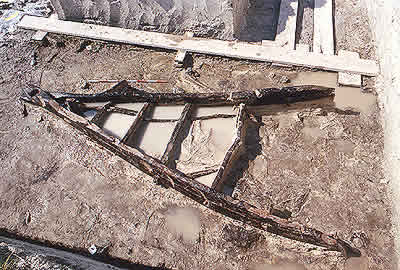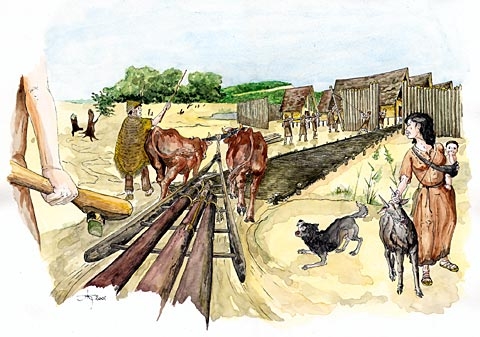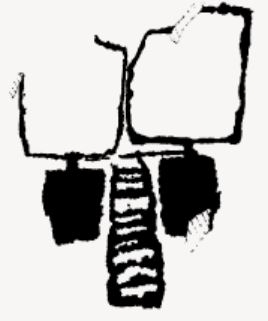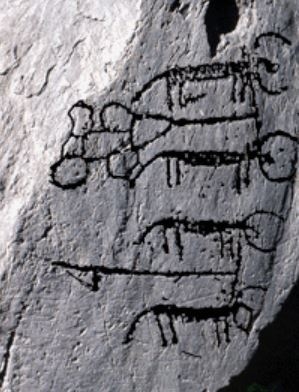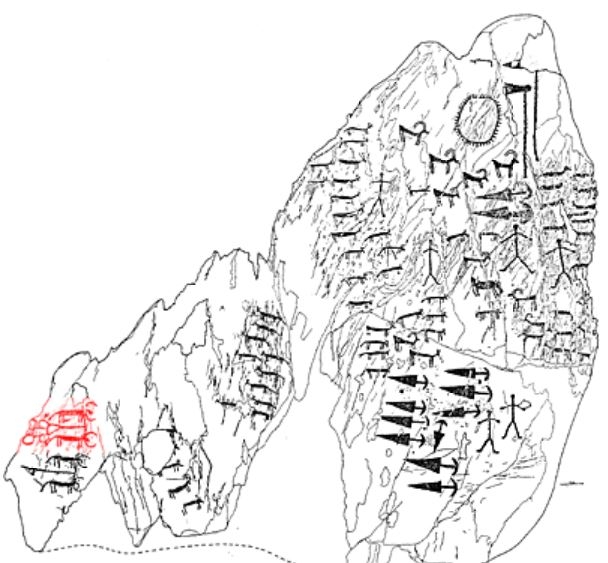- Home
- The village
- An unequal society
- Cattle for the gods
A vehicle for transporting loads
A triangular sledge with two runners was found below and to the side of the isolated Chalain 19 house. Designed to transport heavy loads, this vehicle was drawn by a yoking of oxen which lifted the front part, while the back end dragged on the ground.
Its size is impressive: each runner is 2.8 meters long and there is a 1.3 meter distance between the runner ends. Ash was used for the runners, while oak was used for the original crossbar, which was subsequently repaired with various species of wood.
The front part of the sledge, with its two large runner heads clearly belongs to a technical system of axes used for felling trees. This is clearly a locally produced object. In addition, a 1.53-meter long oak yoke, broken at one end, was attached to the end of the sledge. This was an exceptional discovery, and the first time that an object of this type has been found, although it appears in several rock engravings
Excavation of the sledge.
Chalain 19, 32nd-30th century BCE.
Sledge.
Chalain 19, 32nd-30th century BCE.
Sledge and broken yoke.
Chalain 19, 32nd-30th century BCE.
The technical system of the axe.
© CRAVA / photography P. Pétrequin.
The entrance to the village, the wooden trackway and the palisade.
Watercolor by G. Monthel.
Pairs of cattle for the gods
Before the discovery of the sledge, rock engravings had been found in the Vallée des Merveilles (near Nice) with very rare representations of cattle yoked to this type of vehicle. These engravings, which date very roughly to the late Neolithic period, show horned animals towing trapezoidal frames with transversal crossbars, just like the triangular sledge at Chalain.
Just like images of copper daggers, axes with their handles, cattle, ibexes and deer, depictions of yoked animals were engraved on walls of rock in the Alps during late Neolithic. For example, the Cemmo stele is particularly eloquent: one finds there, among representations of animals, daggers and anthropomorphic figures, two pairs of yoked cattle, one pair pulling a four-wheeled chariot, the other a swing-plough.
Sledge from the Vallée des Merveilles.
Source: H. de Lumley, 1995.
Representation of two pairs of yoked cattle on the Cemmo stele.
Val Camonica, Northen Italy.
The Cemmo stele
the Cemmo stele in a valley in northern Italy displays, from top to bottom, a solar disk, depictions of dogs and animals, daggers and anthropomorphic figures. Finally, at the bottom left, there are two pairs of yoked cattle, one pair pulling a four-wheeled chariot, the other a swing-plough.
Cemmo stele, Val Camonica (Northern Italy).
Source: R.C. de Marinis, 1994.
Solar disc on the Cemmo stele, Val Camonica (Northern Italy).
Source: R.C. de Marinis, 1994.
Dogs and animals on the Cemmo stele, Val Camonica (Northern Italy).
Source: R.C. de Marinis, 1994.
Daggers on the Cemmo stele, Val Camonica (Northern Italy).
Source: R.C. de Marinis, 1994.
Anthropomorphic figures on the Cemmo stele, Val Camonica (Northern Italy).
Source: R.C. de Marinis, 1994.
Pair of yoked cattle pulling a four-wheeled chariot on the Cemmo stele, Val Camonica (Northern Italy).
Source: R.C. de Marinis, 1994.
Pair of yoked cattle pulling a swing-plough on the Cemmo stele, Val Camonica (Northern Italy).
Source: R.C. de Marinis, 1994.
Sacred representation
There is no doubt that these are sacred engravings. We are correct in assuming that, at this period, not all men owned cattle and sledges. The slow spread of certain technical innovations was a sign of the social structures of the period. in the realm of sacred things and gods. It was at this time that great men began to use these innovations to reinforce their social status, and to express the unequal hierarchies that developed around the prestige of warriors and ancestors.
Thus, the presence of a sledge in the proximity of the isolated house at Chalain 19 tends to suggest that this was the house of someone out of the ordinary, whose distinguishing symbols were the same as those found in the realm of the sacred and supernatural.
